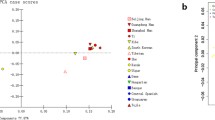Abstract
Hypervariable minisatellite DNA probes 33.15 and 33.6, originally developed for studies in human populations, were used to study genetic variation in chamois (Rupicapra rupicapra). The mean number of bands per individual was 25 for probe 33.15 and 15 for probe 33.6. The average band frequency was 0.33 for both probes. The mean similarity was 0.44, greater than that reported for human and natural populations and close to values found in domestic populations of mammals. This lack of variability could be related to the bottleneck suffered by the population due to large-scale hunting after the Spanish Civil War. Levels of variability are high compared with variability at the level of protein markers, so the use of minisatellite DNA is recommended for future population studies in this species. We did not find large genetic differences between subpopulations, indicating that the population is genetically homogeneous.
Similar content being viewed by others
References
Armour, J. A., and Jeffreys, A. J. (1992). Biology and applications of human minisatellite loci.Curr. Opin. Genet. Dev. 2850.
Baker, C. S., Gilbert, D. A., Weinrich, M. T., Lambertsen, R., Calambokidis, J., McArdle, B., Chambers, G. K., and O'Brien, S. J. (1993). Population characteristics of DNA fingerprints in humpback whales (Megaptera novaeangliae).J. Hered. 84281.
Burke, T., Hanotte, O., Bruford, M. W., and Cairns, E. (1991). Multilocus and single locus minisatellite analysis in population biological studies. In Burke, T., Dolf, G., Jeffreys, A. J., and Wolff, R. (eds.),DNA Fingerprinting Approaches and Applications Birkhauser Verlag, Basel, pp. 154–168.
de Gouyon, B., Julier, C., Avner, P., Georges, M., and Lathrop, M. (1991). Human variable number of tandem repeat probes as a source of polymorphic markers in experimental animals. In Burke, T., Dolf, G., Jeffreys, A. J., and Wolff, R. (eds.),DNA Fingerprinting Approaches and Applications Birkhauser Verlag, Basel, pp. 85–94.
Georges, M. S., Lequarré, A. S., Castelli, M., Hanset, R., and Vassart, G. (1988). DNA fingerprinting in domestic animals using four different minisatellite probes.Cytogenet. Cell. Genet. 47127.
Gilbert, D. A., Lehman, N., O'Brien, S. J., and Wayne, R. K. (1990). Genetic fingerprinting reflects population differentiation in the California Channel Island fox.Nature 344764.
Hanotte, O., Bruford, M. W., and Burke, T. (1992). Multilocus DNA fingerprints in gallinaceous birds: General approach and problems.Heredity 68481.
Jeffreys, A. J., and Morton, D. B. (1987). DNA fingerprints of dogs and cats.Anim. Genet. 181.
Jeffreys, A. J., Wilson, V., and Thein, S. L. (1985a). Hypervariable “minisatellite” regions in human DNA.Nature 31667.
Jeffreys, A. J., Wilson, V., Thein, S. L., (1985b). Individual specific “fingerprints” of human DNA.Nature 31676.
Jeffreys, A. J., Wilson, V., Thein, S. L., Weatherall, D. J., and Ponder, B. A. J. (1986). DNA “fingerprints” and segregation analysis of multiple markers in human pedigrees.Am. J. Hum. Genet. 3911.
Jeffreys, A. J., Royle, N. J., Patel, I., Armour, J. A., MacLeod, A., Collick, A., Gray, I. C., Neumann, R., Gibbs, M., Crosier, M.,et al. (1991). Principles and recent advances in human DNA fingerprinting. InDNA Fingerprinting Approaches and Applications Birkhauser Verlag, Basel, pp. 1–19.
Jones, C. S., Lessells, C. M., and Krebs, R. J. (1991). Helpers-at-the-nest in European bee-eaters (Merops apieaster): A genetic analysis. In Burke, T., Dolf, G., Jeffreys, A. J., and Wolff, R. (eds.),DNA Fingerprinting Approaches and Applications Birkhauser Verlag, Basel, pp. 169–192.
Lynch, M. (1990). The similarity index and DNA fingerprinting.Mol. Biol. Evol. 7478.
Lynch, M. (1991). Analysis of population genetics structure by DNA fingerprinting. In Burke, T., Dolf, G., Jeffreys, A. J., and Wolff, R. (eds.),DNA Fingerprinting Approaches and Applications Birkhäuser Verlag, Basel, pp. 113–126.
Miller, C., and Hartl, G. B. (1986). Genetic variation in two alpine populations of chamois,Rupicapra rupicapra L.Z. Säugetierkunde 51114.
Moore, S. S., Sargeant, L. L., King, T. J., Mattick, J. S., Georges, M., and Hetzel, D. J. (1991). The conservation of dinucleotide microsatellites among mammalian genomes allows the use of heterologous PCR primer pairs in closely related species.Genomics 10654.
Mörsch, G., and Leibenguth, F. (1994). DNA fingerprinting in roe deer using the digoxigenated probe (GTG)5.Anim. Genet. 2525.
Nascetti, G., Lovari, S., Lanfranchi, P., Berducou, C., Mattiucci, S., Rossi, L., and Bullini, L. (1985). Revision of Rupicapra genus. III. Electrophoretic studied demonstrating species distinction of chamois populations of the Alps from those of the Apennines and Pyrenees. In Lovari, S. (ed.),Biology and Management of Mountain Ungulates Croom-Helm, Pondon, pp. 56–62.
Nores, C., and Vazquez, V. M. (1987).La conservación de los vertebrados terrestres asturianos Ministerio de Obras Públicas y Urbanismo, Centro de Publicaciones, Madrid.
Pemberton, J. M., King, P. W., Lovari, S., and Bauchau, V. (1989). Genetic variation in the Alpine chamois with special reference to the subspeciesRupicapra rupicapra cartusiana.Z. Säugetierkunde 54243.
Pemberton, J. M., Albon, S. D., Guinness, F. E., Clutton-Brock, T. H., and Dover, G. A. (1992). Behavioral estimates of male mating success tested by DNA fingerprinting in a polygynous mammal.Behav. Ecol. 366.
Sambrook, J., Fritsch, E. F., and Maniatis, T. (1989).Molecular Cloning. A Laboratory Manual Cold Spring Harbor Laboratory, Cold Spring Harbor, NY.
Stephens, J. C., Gilbert, D. A., Ceci, J. D., Yuhki, N., and O'Brien, S. J. (1992). Estimation of heterozygosity for single-probe multilocus DNA fingerprints.Mol. Biol. Evol. 9729.
Tautz, D. (1989). Hypervariability of simple sequences as a general source for polymorphic DNA markers.Nucleic Acids Res. 176463.
Taylor, A. C., Graves, J. A., Murray, N. D., and Sherwin, W. B. (1991). Conservation genetics of the koala (Phascolarctos cinereus). II. Limited variability in minisatellite DNA sequences.Biochem. Genet. 29355.
Trommelen, G. J., Den Daas, J. H., Vijg, J., and Uitterlinden, A. G. (1993). DNA profiling of cattle using micro- and minisatellite core probes.Biochem. Genet. 24235.
Wetton, J. H., Carter, R., Parkin, D. T., and Walters, D. (1987). Demographic study of a wild house sparrow population by DNA fingerprinting.Nature 327147.
Author information
Authors and Affiliations
Rights and permissions
About this article
Cite this article
Pérez, T., Albornoz, J., Garcia-Vazquez, E. et al. Application of DNA fingerprinting to population study of chamois (Rupicapra rupicapra). Biochem Genet 34, 313–320 (1996). https://doi.org/10.1007/BF00553903
Received:
Revised:
Issue Date:
DOI: https://doi.org/10.1007/BF00553903




